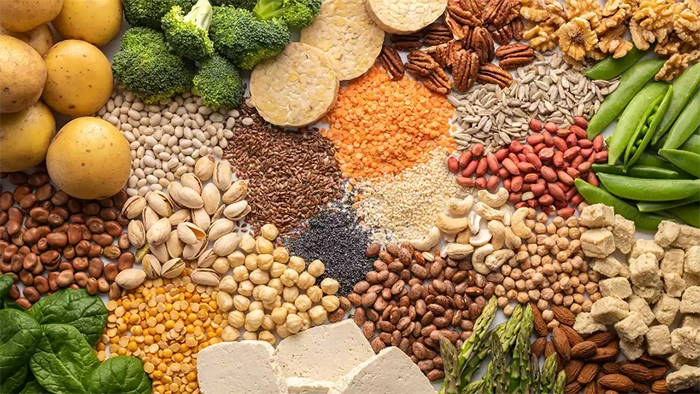I’m here to walk you through the complex procedures of fat and protein metabolism.
Protein Metabolism: The Foundations
Let’s begin by exploring protein metabolism. Consider proteins to be the building blocks of your body. Your muscles, organs, and tissues are repaired and built by them; they’re like competent builders. Your body divides foods containing protein into smaller components called amino acids every time you eat them. Your body uses these amino acids as microscopic building blocks to heal, preserve, and even improve itself.
Imagine your body as a busy construction site with specialized workers using these amino acids as building blocks to repair what is damaged and produce what is required. Protein metabolism makes sure that there is always an adequate supply of amino acids, keeping your body healthy and robust whether it is repairing broken tissues, creating new cells, or supporting numerous biological processes.
Fat Metabolism: A Source of Energy
Let’s switch gears now and discuss fat metabolism. Your body uses fat as a reserve of energy, acting as a sort of emergency fund. Your body saves some of the dietary fats you eat for later use, much like you would save money in a savings account. These fats that have been stored in your body act as little, energy-dense reserves that are easily accessible when you need them right away.
Imagine that your body’s emergency fuel system, the fat metabolism, kicks in when you’re hungry, tired, or in need of a boost in between meals. It’s the mechanism that allows your body to draw on these fat reserves to keep you alive, much like how you may take money from your savings account in times of need.
So how do protein metabolism and fat metabolism work together? They resemble two essential parts of a well-composed symphony. Both are necessary for your body to operate at its peak. While lipids offer a steady supply of energy, proteins are largely responsible for repairing and constructing.
Imagine the protein metabolism as the construction workers concentrating on creating a strong house while the fat metabolism is the generator that runs the lights and appliances. They cooperate well to keep your body functioning normally.
Choosing When to Use: When Does Your Body Decide?
You may now be curious as to when your body chooses to prioritize protein metabolism over fat metabolism, and vice versa. Everything comes down to the availability of energy sources and the immediate requirements of your body.
- Immediate Energy Requirements: Your body likes to use carbs when you require a quick boost of energy, such as during a sprint or in response to an unexpected hunger pain. In terms of energy, carbohydrates are like the quick cash option for your body.
- Sustaining Energy: Fat metabolism takes center stage during moderate-intensity activities like a leisurely walk or modest workout. It gives you a consistent flow of energy to prevent any unexpected crashes.
- Protein as an Extra Measure: If you don’t get enough calories from carbohydrates and fats, your body may unwillingly break down muscle proteins for energy. Protein is typically used for building and repairing tissue. This is why it’s so important to keep a balanced diet.
- Post-Workout Recovery: Your body may use protein to restore and repair muscles that were damaged after an intense workout. For this reason, it’s common to hear advice to eat foods high in protein after doing out to speed up recuperation.
In order to develop a more thorough understanding, let’s delve further into the area of protein metabolism. Your digestive tract begins to work when you ingest protein-rich foods like meat, fish, eggs, dairy products, or lentils. These proteins are divided up into individual amino acids, which are subsequently taken up by your bloodstream.
Imagine your body as a busy construction site where specialized specialists use these amino acids as building blocks to repair, construct, and maintain. They regenerate cells, repair damaged tissues, and aid in the synthesis of antibodies, hormones, and other vital chemicals.
Long-term maintenance and urgent repairs are both concerns of protein metabolism. The amino acids produced by protein metabolism are essential for the ongoing renewal of your skin, hair, and nails.
However, your body may turn to breaking down muscle proteins for energy when necessary, such as during vigorous activity or when you aren’t obtaining enough calories from other sources. This is a last-ditch tactic that can be avoided by eating a healthy diet.
Let’s now examine fat metabolism in greater depth. Your digestive system breaks down dietary fats that you take in from foods like avocados, nuts, seeds, or fatty fish. These fats are converted into fatty acids and glycerol, two smaller molecules that are taken into the bloodstream.
Think of these fats as energy reserves that are safely stored within your body, similar to bank accounts. Your body draws on these fat reserves when you need energy in between meals, when exercising, or even while you’re sleeping, much like you would withdraw money from a savings account.
Fat metabolism is essential for giving your body a steady amount of energy, especially when engaging in strenuous activities like running or taking long walks.
Beyond storing energy, fats also help insulate and protect your important organs. Additionally, they promote your general health and wellbeing by assisting your body in absorbing fat-soluble vitamins including A, D, E, and K.
Dietary Balance: The Secret to Harmony
It is now obvious that protein and fat metabolism play essential roles in maintaining your health as you have learned more about their functions. You need to provide your body the proper nutrients in the right amounts to keep it in balance and sustain harmony.
- Protein: Be sure to eat enough lean meats, fish, poultry, eggs, dairy products, legumes, and nuts as these are excellent sources of protein. This ensures a continuous flow of amino acids for upkeep and repair.
- Fats: Limit saturated and trans fats, which are frequently found in processed and fried meals, and choose the beneficial fats found in avocados, nuts, seeds, and fatty fish instead.
- Carbohydrates: Consume whole grains, fruits, and vegetables that are rich in complex carbs. These offer a consistent source of energy and prevent the utilization of protein as a fuel source.
- Balance: To meet all of your body’s nutritional demands, work to maintain a balanced diet that includes protein, fats, and carbohydrates. It’s like making sure your body has workers and a generator to keep things going as it should.
- Hydrolysis: Never undervalue the role that water plays in metabolism. Your body can carry out these metabolic processes more efficiently if you stay hydrated.
To keep your body functioning at its best, bear in mind that eating a balanced diet and drinking plenty of water is essential. Please don’t hesitate to get in touch if you have any further inquiries concerning the amazing processes that go on inside your body. I’m here to support you as you pursue greater health and comprehension.

